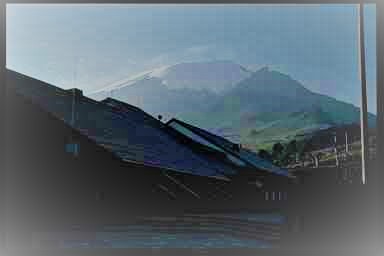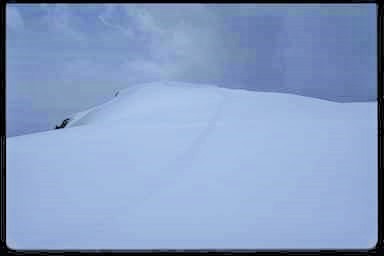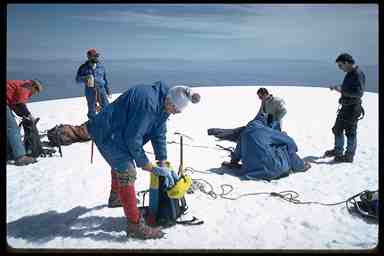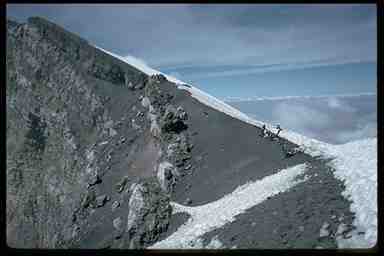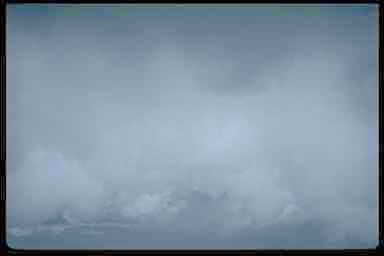Volcanos of Mexico
"Doing the Poli-Poli" or "The Solidarity March to Success"
I spent my vacation this year on a two week trip to Mexico to hike up three different peaks. The trip involved some beginning mountaineering since all three of the peaks are snow- capped. The trip was very successful and the following covers some of the highlights.
Brief Itinerary
We flew to Mexico City where we spent two days. The altitude there is 7,000 feet so we started acclimating right away. We then drove to a climbing lodge at the base of Popocatepetl, the second peak we planned to climb. This was at 11,000 feet. After a night there it was a short drive to the base of Ixtaccihuatl, our first peak. We backpacked two days and on the third day went to the summit (without backpacks), came down and backpacked all the way back out. We returned to the climbing hut. We had a rest day and then went to the summit of Popo and back down in one day. We then drove to Puebla, the 4th largest city in Mexico where we spent the night in a hotel. The next day we drove to the base of Orizaba, our last peak. The next day we attempted to go to the summit of Orizaba. We decided to turn back due to bad weather. We returned to Puebla where we spent two nights. Then back to Mexico City for our farewell fiesta dinner and then our flights back home the next day.
The Peaks
Ixta is 17,300 feet, Popo, 17,800 and Orizaba 18,800. Orizaba is the highest peak in Mexico and the third highest in North America. While it was disappointing not to make it to the summit of Orizaba, we all felt at the time and after we got down that we had made the right decision not to continue. We started out at 3:30 that morning in .5 inch of new snow, fog and wind. Eventually we saw some stars. But before too long we were back in fog. When we decided to turn back about 10am visibility was about 50 feet and we couldn't tell where snow left off and clouds began. There was a steady wind blowing and we had no idea of what the weather was going to do. We still had three hours to go to the summit. That afternoon was we were driving away from the peak we could see that there was just one big cloud hanging over the summit. Our leader referred to it as a lenticular system. About 2:30 p.m. it dissipated in 10 minutes.
To explain the subtitles for this report: poli-poli is Swahili meaning "slowly." Three of the six of us had been up Kilomanjaro where we learned the term. This describes how you go up peaks like this: very slowly, one step at a time. Like the old saying "Slow and steady wins the race." Also going to the summit isn't a race which leads to the second subtitle. Because we were on snow we were roped together. Our trip leader was first on the rope. Once we were about 50 feet from the two peaks we made it up, he halted us and waved us up next to him. We lined up abreast, linked arms and marched to the summit simultaneously. No one was first to the summit or we all were first up. It may sound a little corny but it was a moving experience.
People
There were 6 men signed up for the trip, two from Toronto, two from Poughkeepsie, New York, one from New York City and of course one from Columbus, Indiana. One of the fellows from Toronto had a bad case of altitude sickness and had to go back early. He did make it up Ixta so he made at least one summit.
All three of our guides were Mexican. They were all very qualified and did an excellent job. Our leader, Ricardo Torres, is going to be a member of the Spring 1989 "On Top Everest - 89" expedition.
Effort
This trip was different in a number of ways from my previous trips. The other trips were all treks were we spent a fair amount of time hiking and camping. On this trip we only spent one night in a tent. We did spend two nights in climbing huts but the rest of the time we stayed in very decent lodging. We backpacked two days and spent three days going up to summits and back down. While this may sound easier than spending 3 weeks on the trail, those five days were really tough. The first day backpacking was really exhausting. I was carrying a tent which put my pack near 50 pounds, right near the limit of what I can handle without more training for carrying a load. We were on the trail 5 hours that day. Once we got to the camp site and got the tent pitched I just crawled into my sleeping bag I was so tired.
The days we went up the peaks all started early. For Ixta we started at 5:30 and the day didn't end until about 6:45 that evening. Popo we started up at 4am and got back down about 4pm. Orizaba we started up at 4:30 and turned back at 10am. We got back down about noon. Of course remember we were three hours from the summit when we turned back.
Slides
Unlike all of my previous trips, I did not take very many slides. There were several reasons for this. Exhaustion was one reason. The other reason was that I did not have a good system for carrying the automatic camera that I was using. I did not always have it in a convenient location when I normally would have taken some pictures. I plan to correct this in the future by using a fanny pack except have the pack in front. This would be a good place for carrying things like a small camera, sun screen, sun glasses and other things which should be handy but don't necessarily fit too well in pockets. Before leaving Mexico I talked to some of the others on the trip and have arranged for them to send me 50 or 100 copies of their slides from which I'll put together a show. While I got a number of slides, I need to supplement them this way to come up with a reasonable show.
Follow-up
Ricardo did make the summit of Everest in 1989. He was the first Latin American to summit. He even got to meet the president of Mexico when he returned.
